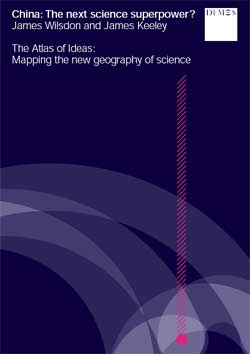| Posted: January 18, 2007 |
Nanotechnology to help China become the next science superpower? |
|
(Nanowerk News) China is on the way to becoming a scientific superpower, thanks to the massive increase in its spending on research and the return of an increasing number of its scientists from abroad, the British think tank Demos has said.
|
|
China in 2007 is the world’s largest technocracy: a country ruled by scientists and engineers who believe in the power of technology to deliver social and economic progress. Right now, the country is at an early stage in the most ambitious programme of research investment since John F Kennedy embarked on the race to the moon. But statistics fail to capture the raw power of the changes that are under way, and the potential for Chinese science and innovation to head in new and surprising directions.
|
|
Is China on track to become the world’s next science superpower? At the same time as it benefits from this dizzying momentum, China faces economic, social and environmental challenges on an unprecedented scale. To overcome these, investment in the hardware of innovation will need to be accompanied by a stronger focus on the ‘software’ of creativity, ethics and research cultures. And China’s drive for ‘independent innovation’ will need to go hand-in-hand with more open and plural forms of ‘cosmopolitan innovation’.
|
 |
|
Demos just plished a 73-page pamphlet "China: The next science superpower?", which forms part of "The Atlas of Ideas", an 18-month study of science and innovation in Asia, with a focus on opportunities for collaboration with the UK and Europe. The project is funded by the UK government and a consortium of public and private sector partners.
|
|
But according to China's plan, it will reshape itself as an innovative nation by 2020, and could become a scientific superpower by 2050.
|
|
"China's Taiwan and South Korea made themselves centres for innovation over the past 20 years, and the Chinese mainland is catching up fast," the report's co-author James Wilsdon said yesterday.
|
|
"In fact, in some growth areas, such as nanotechnology, it is moving even faster than Europe," Wilsdon, head of the Demos innovation team, said.
|
|
One report forecast that the rise of China, India and South Korea would reshape the global innovation landscape. "The centre of gravity of innovation has started moving from the West to the East," the report says.
|
|
The think tank even warned that US and European pre-eminence in scientific innovation could no longer be taken for granted.
|
|
Since 1999, China's spending on research and development has increased by more than 20 per cent a year. It has replaced Japan to become the world's highest spender on R&D after the US. The rising number of multinational R&D centers, steady return of the country's scientists from the US and Europe and the growing pool of graduates will help China realize its goal, Wilsdon said.
|
|
"Beijing's university district alone has as many engineers as all of Western Europe, and you can imagine how dynamic the potential is."
|
|
Two areas that are attracting large amounts of attention and investment in China, as they are elsewhere, are nanotechnology and stem cell biology. These fields are important in terms of their medical and technological potential, but also because the expectations of policy-makers and investors have created ‘economies of promise’ that will intensify the pressure on scientists to deliver quick results.
|
|
With regard to nanoscience and nanotechnology, the report notes:
|
|
"Global research funding [in nanoscience and nanotechnology] is increasing rapidly, and is estimated to have reached US$8.6 billion in 2004.47 China ranks ninth in the world, with US$111 million of funding in 2004 (around one-tenth of what the US spends). This is already yielding impressive results: as noted earlier, China is now third after the US and Japan in the quantity of nanoscience publications it produces (and second in the subfield of nanomaterials).
|
|
The Chinese Academy of Sciences is ranked fourth in the world for nano citations after UC Berkeley, MIT and IBM. According to the China Association for Science and Technology, the three most widely used high-tech words in China today are ‘computer’, ‘gene’ and ‘nanometer’.
|
|
Chunli Bai is one of China’s most celebrated nanoscientists, and an early pioneer of scanning tunnelling microscopy. As vice president of CAS, he has also been an influential voice in furthering China’s advances in this field. Writing in Science, he concludes that:
|
|
The nanoscience and nanotechnology community in China has made remarkable advances across the R&D spectrum, from fundamental scientific research to studies into the potential societal implications of new nanotechnologies.
|
|
His colleague Chen Wang, who is deputy director of the National Centre for Nanoscience and Technology in Beijing, agrees: In terms of citations, our strengths are still underestimated by what is in the academic literature. People like to reference the people they already know, and our nanoscientists aren’t yet well known. But this will change."
|

